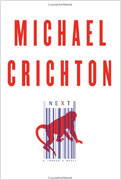A mathematical parrot. A Dutch-speaking orangutan. A chimp that can pass for a boy, albeit a singularly stocky, fuzzy one. These are the otherworldly characters–and provocative thought experiments–that anchor best-selling author Michael Crichton’s most recent novel, Next.
Trained as a physician, Crichton has made a career out of futuristic fiction that takes scientific possibilities to their logical and often terrifying extremes. The Andromeda Strain (1969) tells the story of a plague caused by an extraterrestrial pathogen. Jurassic Park (1990) explores the ethics of cloning by way of a theme park populated by genetically engineered dinosaurs. State of Fear (2004) entertains the possibility that global warming is a manufactured crisis crafted for political gain. In Next, published in November 2006, Crichton takes up genetic engineering again, this time from the vantage point of the law.
Next weaves together several storylines in order to trace the complex and confusing interplay of scientific innovation, legal loopholes, moral limits and economic opportunity. In one, bounty hunters pursue a little boy who has inherited an unusual cell from a grandfather who once unwittingly signed away the commercial rights to his tissues. The courts agree that the University of California — which owns the rights to the cell — can forcibly harvest samples from the child.
In another, a lab technician fears for his job when his drug-addled brother inhales a spray containing a retrovirus used to induce aging in rats. But when his brother suddenly matures into a responsible, sober adult, the technician gets promoted and the company begins calculating how much money it will make with its miraculous, soon-to-be patented “maturity gene.”
In yet another, a scientist discovers that he is the father of a transgenic “humanzee,” the product of an embryonic experiment he had assumed was abortive, and had long forgotten. Dave, the scientist’s half-human son, is a bit hairy and his knuckles have a tendency to drag on the ground. But he can talk, and he can learn, and he is hungry for human contact. The scientist adopts him, integrating him into his family and enrolling him in school.
Other storylines involve a jilted husband who uses the threat of genetic testing to pressure his wife into giving up custody of the kids, a corpse whose bones are secretly removed and sold to biotech researchers, and a parrot named Gerard whose conversational and mathematical abilities stem from an injection of human transgenes he received as a chick. These make-believe plots take their place alongside actual published material centered on the marvels of our biotech age. Crichton reprints a Reuters account of a rabbit that has been genetically modified to make it glow green, text from the website of a gene bank devoted to the prospective cloning of beloved pets (now defunct), and a Wired.com article about a man whose speedboat runs on biodiesel fuel made from the fat of his buttocks.
Together, these real and imagined stories create a troubling portrait of a teeming biotech industry marred by corporate greed, legal confusion and moral uncertainty. Crichton’s is a world in which marketing executives promote the idea of using genetically modified animals to sell their products. It’s a world in which lawyers debate whether one’s body parts might actually be the highly profitable property of someone else. And it’s a world in which no one knows how to think through the biological and ethical dilemmas posed by a science that can rearrange natural boundaries at will. What people in this world are left with, in the absence of scientific and moral clarity, is the corrupting promise of unlimited economic opportunity and a legal system that is frighteningly ill-equipped to cope with the kind of ethical puzzles genetic research raises.
Crichton’s incredible plot thus poses problems that have a strong basis in reality. Consider gene patents, a subject about which Crichton has written extensively. In an op-ed for the New York Times, Crichton explained that over 20% of the genes in our bodies are privately owned — even though the law forbids patenting natural phenomena such as “snow, eagles, or gravity.” Patents exist to protect inventions, Crichton notes; they allow inventors to publish their findings without suffering financial losses, and as such they are meant to encourage the free flow of information and the pursuit of knowledge. In place of a profit-minded secrecy, patents allow for an appropriately profitable transparency.
Who Owns a Disease?
Problems arise, however, when patents are granted to things that exist independent of anyone’s invention–such as genes. “The question of whether basic truths of nature can be owned ought not to be confused with concerns about how we pay for biotech development, whether we will have drugs in the future, and so on,” Crichton wrote in his 2006 New York Times op-ed. “If you invent a new test, you may patent it and sell it for as much as you can, if that’s your goal. Companies can certainly own a test they have invented. But they should not own the disease itself, or the gene that causes the disease, or essential underlying facts about the disease. The distinction is not difficult, even though patent lawyers attempt to blur it.”
Gene patents can impair scientific progress, making it prohibitively expensive for researchers to study certain diseases. This, Crichton notes, is what has happened with Hepatitis C: Researchers have to pay the owner of the Hepatitis C genome so much money for the right to study it that many simply turn their attention to more affordable subjects. Gene patents can also price patients out of the health care market. Because of costly patents, a test for the breast cancer gene that should cost about $1,000 now costs three times that. (Things are working a bit differently in Europe: In 2004, the European Patent Office revoked Myriad Genetics’ patent on a breast cancer gene in order to facilitate cheaper and more widespread screening across the continent.)
How did such an obvious miscarriage of justice come about? Crichton argues that we owe the present situation to the confusion of an underfinanced and uninformed United States Patent Office that did not quite grasp what it was doing when it began issuing gene patents in the late 1970s. Though it is now widely conceded that such patents violate the spirit of the law — and though experts say that in practice patents do more to inhibit innovation than to enhance profits — the Patent Office has continued to grant them.
The legal system that created and upholds gene patents is Crichton’s real quarry in Next. “The courts don’t realize how fast things are changing,” a character observes. “They don’t understand that we are already in a new world. They don’t get the new issues. And because they are technically illiterate, they don’t understand what procedures are done … or not done.”
Crichton’s point is that as science outpaces the understanding of lawyers, judges, and government officers, our ability to maintain a coherent legal position on it is being radically compromised. And, as the examples cited above show, he has written convincingly on this point for some time. In Next, he crafts a novel around this argument as a way of painlessly developing it (a fast-paced story is always easier to follow than a complicated analysis). This might sound like cheating. And from an analytical viewpoint it does leave something to be desired. But a novel offers Crichton something nonfiction does not: It provides him with a way to help readers use their imaginations to grasp the implications of the law as it now stands.
Patenting Genes
Next asks us to question how we know what we know about our reality; indeed, it forces us to wonder whether we know anything at all about it. For Crichton, the limits of the real — the foundational parameters of how we understand life on this earth — are being systematically dismantled by science while we sit complacently by, secure in our unfounded belief that our biology is a settled fact of nature and that our autonomy as individuals within a species, and as a species separate from other species, is not going to be altered or threatened anytime soon.
But Next is not a scare story, and the point of the novel — like the point of Crichton’s other writing on the subject — is not to warn us away from genetic research. It is, rather, to urge us to inform ourselves about it and to take steps to ensure that this most important branch of inquiry is conducted responsibly. The novel even ends with a series of policy recommendations aimed at improving the conditions under which the biotech industry operates. These include ending the practice of patenting genes, establishing clear guidelines for scientific use of human tissue, passing laws to ensure that data about gene testing is made public, avoiding bans on research, and rescinding the Bayh-Dole Act, which allows academic scientists to sell their discoveries to the highest corporate bidder.
At once a truly entertaining thriller and an intriguing policy piece, Next is a compelling contribution to the debate about genetic research. It is also as fantastically hybrid as many of the creatures that populate it: As Crichton’s epigraph mysteriously announces, “This novel is fiction, except for the parts that aren’t.”



